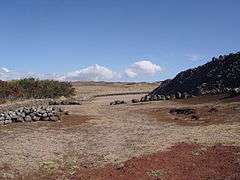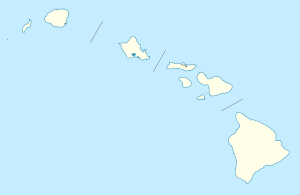Kohala Historical Sites State Monument
|
Mookini Heiau | |
 | |
 | |
| Nearest city | Hawi, Hawaii |
|---|---|
| Coordinates | 20°15′26″N 155°52′36″W / 20.25722°N 155.87667°WCoordinates: 20°15′26″N 155°52′36″W / 20.25722°N 155.87667°W |
| Area | 116 acres (47 ha) |
| Built | 1370 |
| Architect | Kuamo'o Mo'okini; Paʻao |
| Architectural style | Ancient Hawaiian |
| NRHP Reference # | 66000284[1] |
| Significant dates | |
| Added to NRHP | October 15, 1966 |
| Designated NHL | December 29, 1962[2] |
Kohala Historical Sites State Monument includes the National Historic Landmark Moʻokini Heiau and the birthplace of Kamehameha I. It is located in remote North Kohala on the Island of Hawaiʻi.[2]
History

Moʻokini Heiau is one of the oldest historical sites in Hawaiʻi and among its most sacred. Moʻokini means "many lineages" or "many Moʻo" in the Hawaiian Language.[3] Moʻo are large reptile goddesses honored by Hawaiians since before the time of Paʻao.
This heiau is a living spiritual temple and not just an historic artifact of the Hawaiian culture. Oral histories indicate the original temple on the site may be 1500 years old. Evidence suggests the current temple was built on the site of this smaller older one by Paʻao, who brought the Hawaiian Religion to the islands sometime between 1100 and 1300 A.D.
The current site includes the remains of the heiau measuring 250’ x 130’ with an open stone paved court enclosed by 20’-high stone walls, and the sacrificial stone.[4] the heiau is constructed of stones that are said to have been passed from hand to hand from the Pololū Valley, over 12 miles (19 km) away. One tradition states that the heiau was completed by the menehune (mythical Hawai'ian little people) in one night.[5]
For centuries a strict set of rules (kapu) were enforced at the heiau. It was a closed heiau reserved exclusively for the Aliʻi Nui (the highest chiefs) for praying and offering human sacrifices, primarily to the war god Kū. In Kohala Moʻokini Heiau was the focus of religious life and order. In November 1978 Kahuna Nui Leimomi Moʻokini rededicated the Moʻokini Luakini to the “Children of the Land” (kama ʻaina) and lifted the restrictive kapu. In doing this she made the site safe for all persons to enter the heiau and created a place of learning for future generations to discover the past. Her family has been taking care of the temple for centuries.[6]
A few hundred yards away is Kamehameha Akahi ʻĀina Hānau, the birthplace of Kamehameha the Great. He is said to have been born here in 1758 as Halley's Comet passed overhead. The entrance to the site is on the south side. A rock is said to mark the precise place of the birth of Kamehameha.[6]
Location
Kohala Historical Sites State Monument can only be reached by a dirt road from Upolu Airport and is located about 1½ miles off the Akoni Pule Highway. Turn North on Upolu Point road near the town of Hawi, and West at the small air strip. A four-wheel drive vehicle is recommended, especially if it has been raining.[7] The birthplace includes a sign and enclosure located at coordinates 20°15′20″N 155°52′58″W / 20.25556°N 155.88278°W.
The Heiau was declared a National Historic Landmark on December 29, 1962,[2] and added to the National Register of Historic Places in 1966 as site 66000284.[1] A clear day provides a striking view of Maui.[6]
References
- 1 2 National Park Service (2010-07-09). "National Register Information System". National Register of Historic Places. National Park Service.
- 1 2 3 "Mookini Heiau". National Historic Landmark summary listing. National Park Service. Retrieved 2008-06-20.
- ↑ lookup of Moʻokini on Hawaiian place names web site
- ↑ http://focus.nps.gov/pdfhost/docs/NHLS/Text/66000284.pdf
- ↑ All about Hawaiʻi, published by Honolulu Star-Bulletin, 1891, page 117 Google Books
- 1 2 3 Van James, Ancient Sites of Hawaiʻi, 1995, Mutual Publishing, ISBN 978-1-56647-200-5, page 143
- ↑ Kohala Historical Sites State Monument entry on Hawaiʻi State Park web site
External links
 Media related to Kohala Historical Sites State Monument at Wikimedia Commons
Media related to Kohala Historical Sites State Monument at Wikimedia Commons